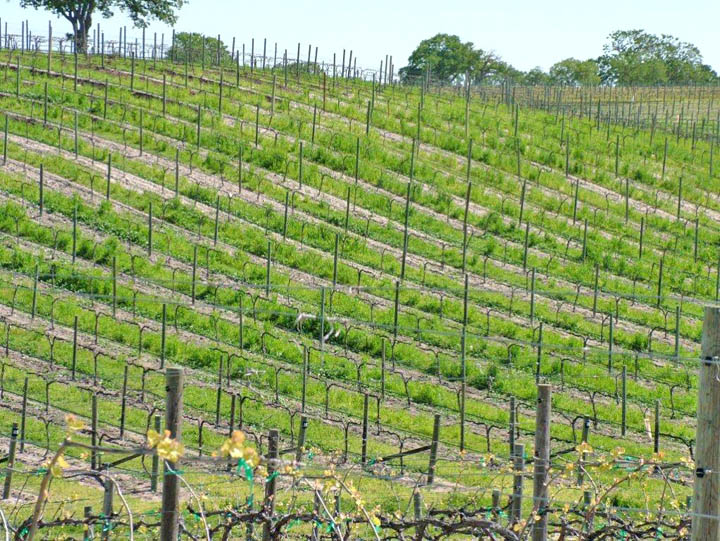
Wine grape growers in the Paso Robles area of the Central Coast were seeing the first green on their vines this season as leaves began emerging in the first week of March. Farther south in the Santa Maria Valley around Los Alamos, shoots had already pushed out about eight inches, reports veteran grower Dana Merrill.
His company, Mesa Vineyard Management, Templeton, Calif., owns and manages 6,000 acres of vineyards in Santa Barbara, San Luis Obispo and Monterey counties.
While leaf out around Paso Robles typically lags the Los Alamos area, the difference seemed to be little wider than usual this year, he notes. That may reflect the limited amount of sunshine the previous week when a storm brought an estimated 3 inches of rain to vineyards east of Paso Robles and around 5 inches on the west side, Merrill says. This follows half an inch or so rain a month earlier, the area’s first precipitation of the year.
More from Western Farm Press
Chipotle ads disgraceful to farmers everywhere
What happens if US loses California food production?
Drought is farmers’ ‘ah-hah’ moment on environmentalism
He figures the east side of Paso Robles has received a total of just over 4 inches since early November, while the west side has had, maybe, around 7 inches altogether. That compares to average annual rainfall of around 13 inches east of Paso Robles to as much as 35 inches on the west, Merrill reports.
“The rain in late February was a godsend,” he says. “It was a nice rain and soaked about 8 to 10 inches in the ground. But, dig deeper than the soil is very dry. The latest rain didn’t do much to make up for the lack of rain that usually falls in November, December and January. It’s unlikely we’d make up the difference in March.”
Meanwhile, he and other growers were on alert in the event of this season’s first frost since bud break.
He wouldn’t be surprised to see some growers in the region try to conserve limited water supplies by removing marginally-productive vines and then hoping for rain to return before replanting next year.
“If a block is getting to the point where aging vines need to be replaced and water availability becomes an issue, some folks may decide to take them out now rather than trying to push things,” Merrill says.
Also, he expects growers to invest in technology to monitor and schedule irrigation to use water even more efficiently.
At the same time, with water tables dropping and pumps bring up more salts, he’s prepared to increase water application rates, if needed, to flush out any build up salts in the root zone of his vines.
Water Questions
Merrill expects pruning activity in the area to have wrapped up the second week of March in most cases. The exception would be any vineyards lacking wind machines or overhead sprinklers to protect against frost. “Then, growers will probably wait until the vines are just at the point where they’re beginning to leaf out and prune at the last minute,” he says.
His crews will be back in the fields sometime in early April or May to remove any unwanted growth on the trunks and cordons of the vines.
He’s encouraged by interest from prospective buyers for his 2014 grapes. “This is the time of year we like to be talking with them,” he says. “In a year of over-supply, we may not hear from them until summer.”
In Paso Robles, much of that interest centers on Cabernet Sauvignon, although father south in the Central Coast, Chardonnay has been generating good demand, he adds.
Still, here, as in every other farming area of the state, drought is on everyone’s mind. With water for vineyards throughout the Central Coast coming entirely from aquifers and water tables continuing to drop, concern is focused on the wells. Will they run dry this season?
“While we don’t’ get water from any of the reservoirs along the coast, water levels in them range from zero to no more than about 30 percent of normal,” he says. “That’s an indication of the supply of ground water in the watersheds.”
That’s why he and other growers as well as non-farming rural homeowners in the Paso Robles area are working to form a water district. This area, which also includes row crops, alfalfa fields, and almond orchards, is one of the few agricultural areas in the state without one, he notes.
“Currently, we all operating individually, hoping to control enough water with the wells on our own property to survive a drought,” he explains. “A water district would allow us to plan for future droughts and to levy fees and borrow money to pay for facilities to store water for use when we need it. As individuals, we can’t do that.”
More from Western Farm Press
Chipotle ads disgraceful to farmers everywhere
About the Author(s)
You May Also Like




